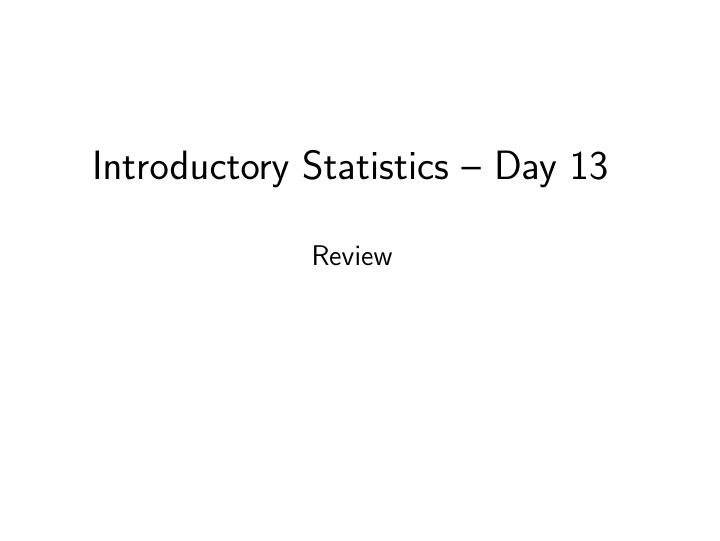



Introductory Statistics – Day 13 Review
Review Activity 1: Reading a histogram: True or False: The tallest bar is 22 units high, so the longest fish must 1 be in that bar.
Review Activity 1: Reading a histogram: True or False: The tallest bar is 22 units high, so the longest fish must 1 be in that bar. Why does that not make sense?
Review Activity 1: Reading a histogram: True or False: The tallest bar is 22 units high, so the longest fish must 1 be in that bar. Why does that not make sense? Where are the longest and shortest fish located in the histogram?
Review Activity 1: Reading a histogram: True or False: The tallest bar is 22 units high, so the longest fish must 1 be in that bar. Why does that not make sense? Where are the longest and shortest fish located in the histogram? Which interval / section of the histogram contains the minimum? 2
Review Activity 1: Reading a histogram: True or False: The tallest bar is 22 units high, so the longest fish must 1 be in that bar. Why does that not make sense? Where are the longest and shortest fish located in the histogram? Which interval / section of the histogram contains the minimum? 2 The lower quartile?
Review Activity 1: Reading a histogram: True or False: The tallest bar is 22 units high, so the longest fish must 1 be in that bar. Why does that not make sense? Where are the longest and shortest fish located in the histogram? Which interval / section of the histogram contains the minimum? 2 The lower quartile? The median?
Review Activity 1: Reading a histogram: True or False: The tallest bar is 22 units high, so the longest fish must 1 be in that bar. Why does that not make sense? Where are the longest and shortest fish located in the histogram? Which interval / section of the histogram contains the minimum? 2 The lower quartile? The median? The upper quartile?
Review Activity 1: Reading a histogram: True or False: The tallest bar is 22 units high, so the longest fish must 1 be in that bar. Why does that not make sense? Where are the longest and shortest fish located in the histogram? Which interval / section of the histogram contains the minimum? 2 The lower quartile? The median? The upper quartile? The maximum?
Review Activity 1: Reading a histogram: True or False: The tallest bar is 22 units high, so the longest fish must 1 be in that bar. Why does that not make sense? Where are the longest and shortest fish located in the histogram? Which interval / section of the histogram contains the minimum? 2 The lower quartile? The median? The upper quartile? The maximum? Why can’t we find the mean and standard deviation for the above 3 histogram?
Review Activity 2: Hypothesis Test Each baby that is born has a 50% chance of being female and 50% chance of being male. A small rural hospital has noticed a jump in baby girls. Last year, 60% of the babies born were girls (27 out of 45) State the null hypothesis 1 State the alternative hypothesis Create a simulator to determine whether the hospital has evidence that 2 something strange is going on or whether this is a typical amount of variation. Find the p-value and explain what the p-value is the probability of in this 3 context. What are your conclusions? 4 How extreme would the gender proportion have to be before you would 5 claim that there is evidence of something unusual at the rural hospital? That same year, a larger city hospital found that 60% of their 400 6 newborns were female. How much would you expect the p-value to change in this situation? Would you expect the conclusions to be different at the city hospital? [Test out your theory with a TinkerPlots simulation] Why does the size of the sample matter in a hypothesis test? 7
Review Activity 3: Finding summary data in an Excel spreadsheet. Download the Counties Data from Moodle. Create a pivot table and put states in the rows. Find the mean, standard deviation, and count for the population of Montana counties in 2010. Find a state with a larger mean for county populations. Find a state with a larger standard deviation for county populations.
Review Activity 4: Have you been doing your reading assignments this term? In order to get an accurate sense of what portion of stats students are doing their reading, we use the following method to protect students from self-incrimination. 180 stats students from this year were asked the following pair of questions Flip a coin. If it’s heads, answer “no.” If it’s tails, answer the following 1 question instead. If you flipped your coin and a got tails, answer “yes” if you honestly read 2 90% of the readings and answer “no” if you did not. Under this method, if a student says “no”, they aren’t incriminating themselves since we don’t know which question they answered. For this experiment, 40% of people said yes and 60% said no. Does this mean that 60% of students in this survey did not do the reading? If so, back this up with a contingency table or tree diagram. If not, estimate whether the percent is likely higher or lower than 60% and why. Then use a contingency table or tree to find an accurate rate of reading.
Review Activity 5: On Your Own Create your own false-positive style conditional probability problem. Show how to solve your problem using a contingency table or tree.
Recommend
More recommend